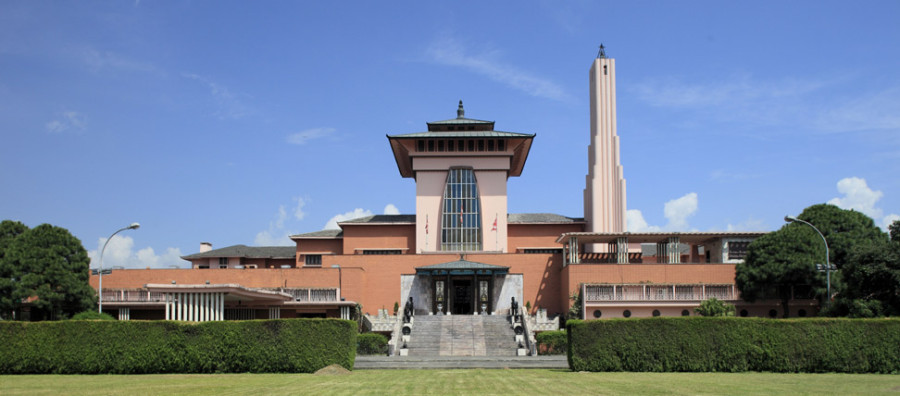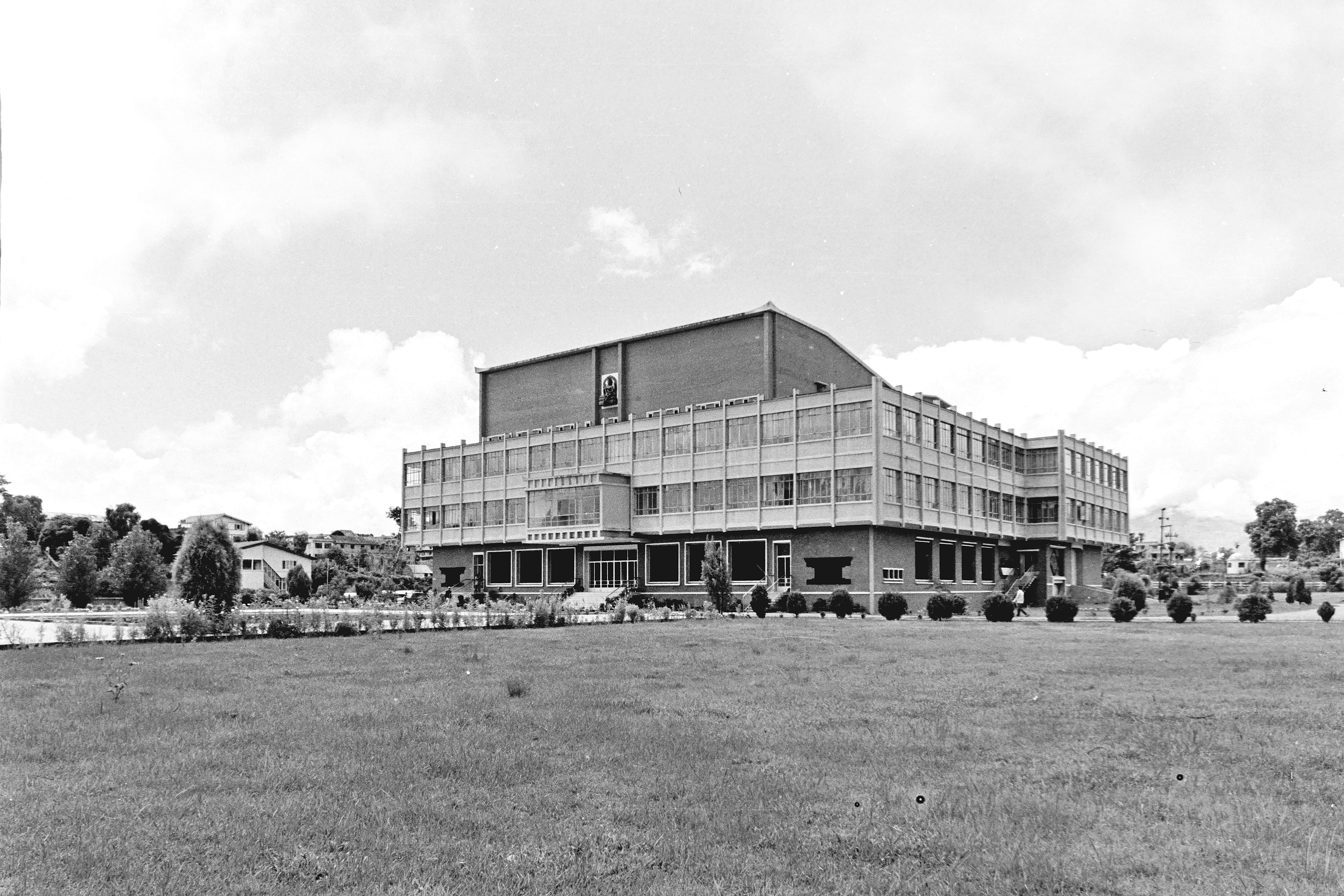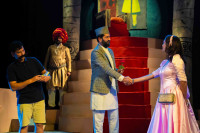Culture & Lifestyle
The early modern architecture of Kathmandu
The exhibition ‘Modern Encounters in Architecture: Kathmandu Valley (1945 - 1985)’, which is taking place at Taragaon Next, aims to draw public attention to an important period in Nepali architecture.
Anish Ghimire
Over the last thirty years, Kathmandu has undergone significant urbanisation, with the city expanding rapidly. This growth has engulfed not only the traditional towns but also areas where early modern buildings were located. As urban areas became more crowded due to reconstruction and soaring land prices, many of these original projects vanished, replaced by uninspiring constructions. However, some early modern architecture projects still stand, albeit in a deteriorated condition.
The exhibition ‘Modern Encounters in Architecture: Kathmandu Valley (1945 - 1985)’, ongoing in Taragaon Next in Baudhha, Kathmandu, aims to bring the attention of the public towards Nepal’s important architectural period. The exhibition organised by Kathmandu Institute has a series of artistic buildings (some of them still standing today) designed by many architects in that particular period.
Kathmandu Institute is a non-government organisation based in Kathmandu for research, learning and debate on contemporary built forms leading to the design and planning of future built landscapes in the region.
One of the founding members of the Institute, Jharna Joshi says, “We have been working on this documentation project since 2020, researching and collecting information included in the exhibition and the book.”
A book of the same title was also launched recently.
In the past few years, modernisation has choked the artistic side of architecture in Kathmandu. As a result, the metropolitan area now lacks public spaces, carefully planned buildings, a purposeful aesthetic, sufficient infrastructure and eco-friendly conditions.
Market demands and lacking planning oversight fueled this surge in construction. Consequently, the Valley witnessed a proliferation of mundane and uninspired buildings, completely ignoring the traditional and early modern architectural styles. As a result, the unique urban landscape of the Valley has been transformed into an indistinguishable sprawl, blending in with generic global developments.
In one of the instalments in the exhibition, we see the works of civil engineer Shankar Nath Rimal. In the 1960’s he was given the responsibility to supervise the construction of the new Narayanhiti Palace complex designed by Benjamin Polk. According to a statement provided by the gallery, King Mahendra himself invited the American architect Polk to work on the designs for the Narayanhiti Palace.

While working on the design, Polk kept in mind that the Palace should be the first focus for the pride and culture of modern Nepal. As a part of the USAID’s support for Nepal’s Higher Education Program, Polk was tasked with designing five projects in the Kathmandu Valley: the Sanothimi Campus, Janak Shiksha Kendra, Adarsha High School in Sanothimi, Laboratory School in Kirtipur and the Central Department of Education in TU, Kirtipur.
These designs not only provided innovative architectural solutions but also harmonised with the landscape while showcasing new architectural possibilities. Additionally, they introduced daring and inventive structural concepts and construction methods for different buildings, considering the skills, materials and costs available at the time.
Joshi says, “These buildings reflect the movement towards modernisation that brought new functions, styles, materials and innovative construction technologies to the architectural landscape of Nepal.”
As for Rimal, in addition to numerous remarkable residential projects, he also designed the Nepal Academy building in Kathmandu. This structure showcased the organisation of technically intricate architectural programmes and introduced advanced structural solutions for the first time in Nepal. Furthermore, he was responsible for designing the new Foreign Ministry Building in the Singha Durbar campus, which features a slim office tower atop a spacious square base. The range of his projects spans small residences, mansions, hotels, banks and factories as well as plans for a new town in Tikapur.

Over his six-decade career, Rimal has crafted numerous remarkable buildings and structures that have proven resilient against the test of time and earthquakes. Unfortunately, many of his original drawings have been lost.
Especially during the time of 1945-1985, the Kathmandu Valley witnessed the rise of numerous significant modern building projects crafted by both Nepali and foreign architects, with the Narayanhiti Palace being one of them. These early modern structures possessed a unique identity, distinct from the traditional architecture of the Valley. However, they were conceived to preserve and advance the traditional aspirations, enriching the architectural splendour of the region without undermining its symbolic or cultural significance.
Another important figure in Nepali architecture during the transitional period from the last years of the Rana Period, (pre-1950) to the early years of the modernisation of Nepal (post-1950) is Beda Prasad Lohani. He constructed Nepal’s very first modern Reinforced Cement Concrete (RCC) building at Tri-Chandra College. Saraswati Sadan, also designed by Lohani, serves as both a library and academic building, incorporating various innovative building technologies including RCC slabs, large cantilevers and reinforced masonry walls for spacious construction.
Stylistically, it adopted motifs and elements from Art Deco architecture, a popular style in South Asia during that era. Additionally, he designed Ranjana Cinema Hall, a sizable residence in Yetkha Tole in Kathmandu and numerous modern residences across the city. This architectural style was also embraced by other prominent designers and builders of the time, like Kul Ratna Tuladhar, who designed the Ashok Cinema and Lekhnath Khanal, responsible for many residential designs.
.jpg)
The early modern buildings (like these) in Kathmandu were designed to fit the needs of their purpose, using new construction methods and designs inspired by modern architecture. They aimed to keep up with the changing world by using new technologies and organising space in a logical way. These designs often used materials and skills that were easily available locally, but they were used in creative ways to come up with fresh and inventive results.
Gathering materials on early modern buildings has been challenging for the organisers due to inadequate archiving and care, resulting in diverse formats scattered across various sources. These include private storage, national and international agencies, institutional archives and online platforms, ranging from sketches on parchment paper to blueprints, slides and photographs.
By retrieving materials from diverse sources and formats, the project aims to prevent the fading of early modern buildings into obscurity. It emphasises the value of these structures, not only in the Kathmandu Valley but also in other parts of Nepal. “The objective of this documentation is to understand and initiate a dialogue on the value of these projects in the architectural history of Nepal. It also intends to bring this knowledge to the general public, hopefully leading to their legal protection,” says Joshi.

Modern Encounters in Architecture
Where: Taragaon Next, Bauddha, Kathmandu
When: Until April 18
Timings: 10:00 am to 5:30 pm




 10.12°C Kathmandu
10.12°C Kathmandu




.jpg&w=200&height=120)










